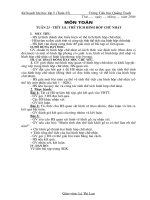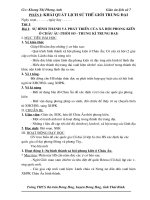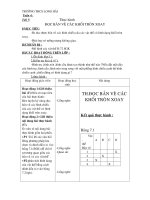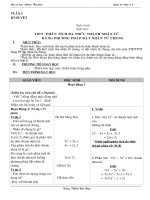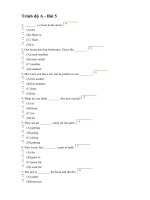Flow past a rotating circular cylinder 5 7
Bạn đang xem bản rút gọn của tài liệu. Xem và tải ngay bản đầy đủ của tài liệu tại đây (9.05 MB, 91 trang )
Chapter 5 PIV measurement
99
Chapter 5 PIV Measurement
Up to the present stage, the flow around the rotating circular cylinder has been studied by
flow visualization and hot-film anemometry method. While flow visualization gives
qualitative information of the flow behaviour around the cylinder, hot-film anemometry is
used to measure the flow velocity at discrete locations. The above two methods give a
general understanding of the flow structure around the rotating cylinder. However, to
obtain a more in depth understanding of the flow, quantitative information of the whole
flow field will be highly desirable. In the present chapter, the flow structure around the
rotating circular cylinder will be investigated by using the Particle Image Velocimetry
(PIV) method.
In the present chapter, PIV measurement is carried out at Reynolds number (Re) of 110,
206, 334, 541 and 1067 and speed ratio () in the range of 0 to 5. The flow structure
around the rotating cylinder will be studied in two parts: the streamwise (in x-y plane)
and the spanwise (in a plane parallel to the x-z plane) structure of the flow.
In the first part, PIV measurement is carried out in a cross section plane of the cylinder at
the cylinder’s mid span (of the immersed part). The vortex shedding process is
investigated by studying the vorticity contours and streamline patterns in the surrounding
field of the cylinder surface and in the wake of the cylinder. The characteristics of the
vortex street (Strouhal number (St), vortex spacing ratio and velocity fluctuation profile
in the wake of the cylinder) are estimated based on the plots of vorticity contours and
streamline patterns. These parameters will be compared at different Re and to study the
effect of the two flow parameters on the vortex street. Besides, the behaviour of the flow
at high speed ratio will be studied in greater detail by examining at PIV results in the
close surrounding field of the cylinder surface. The results presented in this chapter is for
Chapter 5 PIV measurement
100
a left to right flow past an anti-clockwise rotating cylinder as shown in the below figure
(same as Figure 4.1 in Chapter 4).
Figure 5.1 Definition sketch of flow past a rotating circular cylinder.
Figure 5.2 Definition sketch of spanwise PIV plane position.
In the second part, spatial structure of the flow field is investigated by PIV measurement
in a plane parallel to the cylinder centre axis and at a distance of 1mm (0.56D from centre)
from the cylinder (as shown in Figure 5.2(b) above). Mode A and mode B instability are
identified based on the three-dimensional instability (for non-rotating circular cylinder)
discussed in Williamson (1996). Vorticity contours and streamline patterns at different Re
z
U
x
y
PIV
p
lane
PIV
p
lane
b) View from top of the cylinder
a) View from one side of the cylinder
U
0.56D
U
PIV
p
lane
11D
10.9D
1.8D
c) Size of captured PIV view and position of cylinder in the PIV plane
x
z
U
x
y
D
U
D
2
Chapter 5 PIV measurement
101
and α are presented and analysed to study the effect of the cylinder rotation on the
spanwise vortex structure of the cylinder.
It is hoped that the results obtained will help researchers to gain better understanding of
the flow structure around the rotating circular cylinder, which has been an important issue
of many studies over a long period of time.
5.1 Stationary cylinder
5.1.1 Flow structure in the surrounding of the cylinder surface
a. Time-averaged velocity profile
The statistical data at different Reynolds numbers (110, 206, 334, 541 and 1067) were
obtained by PIV measurement based on the time average of around 334-400 sets of
sequential data (which cover more than thirty vortex shedding cycles). The velocity
magnitude is non-dimensionalised by the free-stream velocity, and the time-averaged
velocity vectors in the whole flow field of 8.5D by 8.5D around the cylinder are shown in
Figure 5.3. The colour map and colour bar show the magnitude of the normalized velocity
vectors. As shown in the plots, the expected symmetry of the mean velocity profiles with
respect to the flow field centre axis (an axis parallel to free-stream flow) is observed
which shows that a sufficient number of data set has been used for averaging.
In Figure 5.3, although the magnitude of the non-dimensional mean velocity varies
almost within the same range of magnitude (0-1.3 as shown in the colour bars of Figure
5.3), a slightly lower range of magnitude and a visible difference in the size of the mean
wake region can be observed in the velocity profile plot at Re = 110 when compared to
the other cases. It can be seen at Re = 206, the wake region is smaller than that at Re =
110, but is slightly bigger than that for Re = 334. On the other hand, for Re 334 where
Chapter 5 PIV measurement
102
the flow is in the 3D regime, the mean wake region elongates with increasing Reynolds
number. Based on the category of different flow regimes reported in Williamson (1996)
(see section 2.1.1), the flow at Re = 110 is considered to be in laminar vortex shedding
regime, the flow at Re = 206 is in the 3D wake-transition regime and the flow at Re of
334, 541, 1067 are in 3D regime.
Chapter 5 PIV measurement
103
Figure 5.3 Time-averaged velocity profile (U
ave
/U
) for stationary cylinder at Reynolds
number of a) 110; b) 206; c) 334; d) 541; and e) 1067.
The time-averaged streamwise velocity profile (
a)
b) c)
d) e)
0
6
4
0
1 2 3 4 5 6 7
-1
0
1
2
3
-4
-3
-2
-1
4
0
1 2 3 4 5 6 7
-1
0
1
2
3
-4
-3
-2
-1
4
0
123 4 56 7
-1
0
1
2
3
-4
-3
-2
-1
4
0
1 2 3 4 5 6 7
-1
0
1
2
3
-4
-3
-2
-1
4
0
1 2 3 4 5 6 7
-1
0
1
2
3
-4
-3
-2
-1
b)
c)
d) e)
Chapter 5 PIV measurement
104
Figure
5.5) shows that along the cylinder’s wake centerline, the streamwise velocity
(u
ave
/U
) increases rapidly downstream up to a distance of around 4D from the cylinder
centre (with a gradient of around 38% for Re > 110, as shown in the trend-line’s gradient
in
Figure
5.5) and the increase slows down there after. For the Re = 110 case, u
ave
/U
increases up to 6D downstream of the cylinder centre before slowing down. The above
can also be observed in the green colour region of the time-averaged velocity profile
shown in Figure 5.3. At Re = 110, the wake (green region) still develops at x/D > 6,
whereas for Re 206, the wake stops widening at x/D > 4.5. The 2D computation from
Griffin (1995) of the mean velocity along the wake centerline at Re = 200 is also shown
in Figure 5.5. Griffin’s U
ave
/U
data show a trend similar to the present U
ave
/U
data, but
both the sharp rise and leveling off of the referenced U
ave
/U
take place at smaller x/D
(sharp rise starts from 0.8D and leveling off starts from 2.5D downstream of the cylinder
centre) compared to that of the current data (sharp rise and leveling off starts at around
1.8D and 3.8D downstream, respectively). If the data of Griffin (1995) is shifted 1D along
the x/D axis, the referenced computational results will agree well with the present
experiment’s results. The gradients (within the rapid increasing region) of the streamwise
velocity at Re of 206, 334, 541 and 1067 are almost the same at around 32%. After
leveling off at around 2.5D, the data of Griffin (1995) seems to match with the present
data at Re = 206. It seems that the mean velocity profile at Re = 206 of the present result
within the mean wake region (the blue color region in the color map shown in Figure 5.3
b) which length is around 2.5D) is quite different from that at Re = 200 in the
computation of Griffin (1995). However, beyond this mean wake region, the results of
both present experiment and Griffin’s computation start to agree with each other.
Chapter 5 PIV measurement
105
Figure 5.4 Time-averaged streamwise velocity profile along the centreline of stationary
cylinder.
Figure 5.5 Time-averaged velocity magnitude profile along the centreline of stationary
cylinder.
The time-averaged cross-flow velocity at x = 3.4D (Figure 5.6) varies along the
cross flow direction in an anti-symmetric manner which is expected as the cylinder wake
is symmetrical with respect to the cylinder centreline. The peak value of the cross-flow
Time-averaged streamwise velocity profile
y = 0.3825x - 0.5536
-0.3
-0.1
0.1
0.3
0.5
0.7
0.9
01234567
x/D
uave
/U
inf
Re=110
Re=206
Re=334
Re=541
Re-1067
Linear (Trendline)
u
ave
/U
Trend-line based
on data at Re =
206 from x
1.8D to x 3.8D
Time-averaged velocity profile
y = 0.3155x - 0.3868
-0.3
-0.1
0.1
0.3
0.5
0.7
0.9
01234567
x/D
U
ave
/U
inf
Re=110
Re=206
Re=334
Re=541
Re-1067
Re=200 (regenerated
from Griffin(1995))
Linear (Trendline)
U
ave
/U
Trend-line based on
data at Re = 206 from
x 1.8D to x 3.8D
U
ave
/U
Chapter 5 PIV measurement
106
velocity increases with increasing Re. This shows that within the wake region of the
cylinder, the Reynolds number has a strong effect on the maximum cross-flow velocity
component.
Figure 5.6 Time-averaged cross-flow velocity profile of stationary cylinder wake at x =
3.4D downstream of the cylinder.
b. Vorticity contour and streamline patterns
In Figure 5.7 a) to e), the time-averaged vorticity contour plot and streamline patterns
are symmetrical with respect to the cylinder’s centreline as expected for the case of flow
past a stationary cylinder. Consistent with the average velocity contour discussed in the
previous section, here it is noted that the recirculation region (seen in the streamline
patterns) at Re=110 is bigger than that at Re=206, and it elongates with increasing Re.
The two opposite sign vortices are growing in strength and the vorticity region is also
Time-averaged cross-flow velocity profile
-5
-4
-3
-2
-1
0
1
2
3
4
5
-0.25 -0.2 -0.15 -0.1 -0.05 0 0.05 0.1 0.15 0.2 0.25
y/D
Re=110
Re=206
Re=334
Re=541
Re=1067
V
ave
/U
Chapter 5 PIV measurement
107
elongated with increasing Re for Re > 206. This trend was also observed through flow
visualization at Re = 141, 296 and 592 and was discussed in section 4.1.1.
To the author’s best of knowledge, there is no report on this trend of “wake time-
averaged recirculation region elongates with Re” in the open literature. Gerrard (1966)
suggested the increase in the formation region length with increasing turbulence level, but
this change was not discussed in detail.
y/D
0
1
2
3
-3
-2
-1
0 1 2 3 4 5 6
y/D
0
1
2
3
-3
-2
-1
0 1 2 3 4 5 6
a) Re = 110, α = 0.
x/D
y/D
0
1
2
3
-3
-2
-1
0 1 2 3 4 5 6
y/D
0
1
2
3
-3
-2
-1
0 1 2 3 4 5 6
x/D
b) Re =206, α = 0.
Chapter 5 PIV measurement
108
Figure 5.7 Vorticity contour and streamline plots of a stationary cylinder at a) Re = 110,
b) Re = 206, c) Re = 334, d) Re = 541 and e) Re = 1067.
c. Characteristics of the vortex street
y/D
0
1
2
3
-3
-2
-1
0 1 2 3 4 5 6
y/D
0
1
2
3
-3
-2
-1
0 1 2 3 4 5 6
c) Re = 334, α = 0.
x/D
y/D
0
1
2
3
-3
-2
-1
0 1 2 3 4 5 6
y/D
0
1
2
3
-3
-2
-1
0 1 2 3 4 5 6
x/D
d) Re = 541, α = 0.
y/D
0
1
2
3
-3
-2
-1
0 1 2 3 4 5 6
y/D
0
1
2
3
-3
-2
-1
0 1 2 3 4 5 6
x/D
e) Re = 1067, α = 0.
Chapter 5 PIV measurement
109
Based on the time series data of the PIV measurement, the vortex shedding frequency
(f) is estimated by measuring the time between two consecutive vortices from the PIV
vorticity contour images at an arbitrarily fixed “reference” position (one shedding cycle).
The vortex shedding frequency is calculated by averaging around 20 (for Re = 110) to 50
(for Re = 1067) cycles of vortex shedding. The Strouhal number is then calculated by
U
Df
St
.
. Figure 5.8 below shows that Strouhal number increases gradually with
increasing Reynold numbers. The comparison in Figure 5.9 shows a rather good
agreement between the current PIV results with the experimental data reported in
Williamson (1992) as well as the author’s earlier hot-film measurement data. The
Strouhal number at Re = 160 falls into the mode A regime in the plot, while Strouhal
number data drops to the transition regime at Re = 206 and continues to mode B regime
for Re = 334. The value of St at Re = 334 observed from PIV is slightly lower than the St
value obtained from hot-film measurement at around Re = 340. The difference is
generated from error during the counting of vortex shedding cycles based on
instantaneous PIV images.
St vs. Re
0.12
0.14
0.16
0.18
0.2
0.22
0.24
0.26
0.28
0 200 400 600 800 1000 1200
Re
St
Figure 5.8 Strouhal number (from PIV data) versus Reynolds number for flow past a
stationary cylinder.
Chapter 5 PIV measurement
110
Figure 5.9 Comparison of the current PIV St-Re data with the author earlier hot-film
measurement and the data reported in Williamson (1992).
The current St-Re data as shown in Figure 5.10 also follow quite well the universal
St-Re relationship curve published in Fey et al. (1998) and Williamson et al.(1998) (for
3D regime Re > 180). The current PIV data do not fall onto the 2D universal St-Re curve
reported by Williamson et al. (1998), which is reasonable as the flow in the present
experiment is expected to be three-dimensional.
St-Re
0.12
0.16
0.2
0.24
0.28
0 200 400 600 800 1000
Re
St
present hot-film
measurement data
2D universal St
(Williamson et al (1998))
universal St (Fey et al
(1998))
universal St for 3D
regimes Re>180
(Williamson et al (1998))
present PIV data
Figure 5.10 Strouhal number versus Reynolds number for stationary cylinder, in
comparison with hot-film measurement and universal St-Re relation reported in the
literature.
Hot film measurement
Current PIV data
St
Williamson
(
1992
)
Re
Chapter 5 PIV measurement
111
The agreement among the present PIV data and literature data gives some indication
of the accuracy of the present experiment.
5.1.2 Flow structure in the spanwise direction of the stationary
cylinder
As described in Figure 5.2, PIV measurement is carried out in a plane parallel to both
cylinder axis and free stream velocity. The data is captured in a 10.9D by 11D area of
view. In all the spanwise PIV data presented here, the cylinder axis is at a distance of
1.2D from the left edge of the figures. The spanwise vorticity contours at some instances
of time at Re = 206, 334, 541 and 1067 are shown in Figure 5.12. By averaging over a
number of instantaneous plots of vorticity contour (around 10 plots), the spanwise
wavelength of the three dimensional instability are estimated and shown in the Table 5.1
below. Mode A instability occurs at Re = 206 which has a spanwise instability
wavelength of around 4.1D. Mode B is observed for Re = 334, 541 and 1067 which has a
spanwise instability wavelength of around 1.24D, 1.25D and 1.51D, respectively. Under
the current experimental conditions, mode B instability wavelength is around 1.24-1.51D
and the wavelength slightly increases with increasing Re.
Re 206 334 541 1067
Wavelength 4.1 D 1.24 D 1.25 D 1.51 D
Table 5.1 Spanwise instability wavelengths for stationary cylinder.
Chapter 5 PIV measurement
112
Figure 5.11 Spanwise instability wavelength in comparison with literature (regenerated
from Williamson(1996)).
It can be seen that the current PIV data at Re = 206, 334 and 541 agree quite well
with those reported in literature (Figure 5.11).
When the flow is in mode A or mode B regime, with increasing Re, the centres of
those streamwise vortices appear to form a line that is inclined to the cylinder axis (as
indicated by the dotted line seen in Figure 5.12). This phenomenon of inclined vortex
shedding is likely to be caused by difference in the end conditions of the present cylinder.
In the present experiment, the cylinder end conditions are different; at one end the
cylinder pierces through the free water surface, whereas at the other end the cylinder
terminates at the bottom of the water channel test section. In the current range of Re from
206 to 1067, within the captured view area, the inclination of the spanwise vortex cores
was observed to be always 9
o
or less.
Current PIV da
t
a
/D
Re
Chapter 5 PIV measurement
113
In the literature there are a number of studies that report on the oblique shedding mode of
the stationary cylinder. Various methods to manipulate inclined vortex shedding had been
suggested. They all include the manipulation of the cylinder end conditions. A summary
of four of the methods is reported in Williamson (1996). In the next section on flow past a
rotating cylinder, the author will study how the rotation of the cylinder can affect this
phenomenon of oblique vortex shedding.
4.2D
4.7D
y/D
0
1
2
3
4
5
-4
-3
-2
-1
x/D
0 1 2 3 4 5 6 7 8 9 10
-5
a) Re = 206
0 1 2 3 4 5 6 7 8 9 10
2.4D
2.4D
y/D
0
1
2
3
4
5
-4
-3
-2
-1
x/D
-5
b
) Re = 334
Chapter 5 PIV measurement
114
Figure 5.12 Spanwise vorticity contour for stationary cylinder at a) Re = 206, b) Re =
334, c) Re = 541 and d) Re = 1067.
5.2 Rotating cylinder
In the previous section, the PIV measurement for flow past a stationary circular
cylinder was discussed. As studies on flow past a stationary cylinder have been widely
reported in the literature, the most important purpose of the previous section is to
compare the current PIV measurement data with literature to confirm the accuracy of the
present experiment. The reasonably good agreement among the present data and the
5D
5D
y/D
0
1
2
3
4
5
-4
-3
-2
-1
x/D
0 1 2 3 4 5 6 7 8 9 10
-5
c) Re = 541
7.6D
6D
y/D
0
1
2
3
4
5
-4
-3
-2
-1
x/D
0 1 2 3 4 5 6 7 8 9 10
-5
d) Re = 1067
Chapter 5 PIV measurement
115
reported data shows that the present experimental setup and methodology are capable of
accurate results. This will help to assure the quality of the following data for flow past a
rotating circular cylinder, which unlike flow past a stationary cylinder, had been much
less reported, especially experimental investigation.
The flow structure around the cylinder will also be studied in two directions:
streamwise direction (in the cross-sectional plane, the x-y plane) and spanwise direction
(in the spanwise plane parallel to cylinder axis, a plane parallel to the x-z plane). The flow
structure in the surrounding of the cylinder surface (in the cross-sectional plane) will be
studied by analysing the vorticity contour and streamline patterns at different Re and .
As reported in the literature, vortex shedding disappears at a sufficient high speed ratio .
The flow structure will therefore be analysed in two categories: low region where
vortex shedding still exists and high region where vortex shedding disappears. Besides,
some parameters that quantifies the flow structure will also be estimated and presented.
The spanwise flow structure will also be shown in the last part to study how mode A and
mode B flow instabilities are affected by the cylinder rotation.
The result will be presented for Reynolds numbers of 110, 206, 334, 541 and 1067
(same as the stationary cylinder case) for streamwise flow structure and Reynolds
numbers of 206, 334, 541 and 1067 for spanwise flow structure, and speed ratio in the
range of 0 to 5.
5.2.1 Flow structure in the surrounding region of the cylinder
surface
a. Time-averaged flow structure at low speed ratio
Figure 5.13 shows the movement (indicated by arrow) of the time-averaged
positive vortex core when increases at different Re. The centre of the cylinder is at the
Chapter 5 PIV measurement
116
origin of coordinates in the plot. The position of the vortex core (x/D, y/D) with respect to
the cylinder centre is approximately estimated by measuring the distance of the centre of
the vorticity region in the streamline pattern contours to the centre of the cylinder. It
seems that the counter clockwise vortex moves closer to the cylinder surface at higher
speed ratio. It can be said that, in the close region around the cylinder surface, is the
more important flow parameter and the Reynolds number does not show a significant
effect on the vortex structure.
Figure 5.13 Movement of positive vortex core with increasing (when increases from
1 to 2 then to 2.5).
The well known von Kármán vortex street was observed at below 3, the negative
clockwise vortex and positive counter-clockwise vortex are shed alternatively
downstream. With increasing Reynolds number, the shed vortices are elongated (observed
when all vorticity contours at different Re are plotted in the same scale of vorticity
strength), and the wake is slightly “straightened”.
The rotation of the cylinder has a strong effect on both the inclination and the width of
the cylinder wake. With increasing , the cylinder wake becomes narrower and is
deflected in the cylinder’s rotation direction, as seen in the vorticity contours shown in
0
0.1
0.2
0.3
0.4
0.5
0.6
0.7
0 0.2 0.4 0.6 0.8 1 1.2 1.4 1.6 1.8
x/D
y/D
Re=110
Re=206
Re=334
Re=541
Re=1067
Chapter 5 PIV measurement
117
the Figure 5.14 to Figure 5.18 below. When α increases, both the top and bottom flow
separation positions appear to move in the same direction of the cylinder rotation
(counter-clockwise in the current study), with the bottom separation position (the side
where the cylinder surface moves in the same direction of the free stream) showing more
significant movement. When increases, the streamwise velocity at the lower part of the
cylinder becomes increasingly higher than the streamwise velocity at the upper part of the
cylinder (can be observed in the time-averaged velocity profiles for Re = 110 shown in
Figure 5.19). The above may result in the fast movement of the bottom flow separation
position. At the same time, the overall streamline patterns are increasingly deflected
toward the cylinder’s rotation direction. With increasing , the cylinder’s rotation adds
more asymmetry in the pair of opposite sign vortices, and the counter-clockwise vortices
(red colour, which rotate in the same direction as the cylinder rotation) become more
dominant when compared to the clockwise vortices (blue colour).
At Re = 110 (Figure 5.14), the two opposite sign vortices seem to be more
“concentrated” in the immediate vicinity of the cylinder surface at higher . The counter-
clockwise vortex (red colour) covers up more of the cylinder surface, while the clockwise
vortex (blue colour) covers less with increasing . This process of domination of the
positive vorticity region gradually happens when increases. For higher Reynolds
numbers of 206, 334, 541, 1067 as shown in Figure 5.15, Figure 5.16,
Figure 5.17, Figure 5.18 respectively, the dominance of the positive counter-
clockwise vortex also happens gradually with increasing . At these higher Reynolds
numbers, with increasing Re, the free stream flow seems to have a “larger” effect on the
vortex structure around the cylinder by delaying the movement of the bottom separation.
However, the effect of Re does not show significant effect on the “process of dominance”
Chapter 5 PIV measurement
118
of the positive vortex on the cylinder surface when the vorticity contour and streamline
pattern plots at the same value of but different Reynolds numbers are compared.
y/D
0
1
2
3
-3
-2
-1
0 1 2 3 4 5 6
y/D
0
1
2
3
-3
-2
-1
012 3 4 5 6
x/D
a) Re
=
110,
=
0.5
x/D
y/D
0
1
2
3
-3
-2
-1
0 1 2 3 4 5 6
y/D
0
1
2
3
-3
-2
-1
012 3 4 5 6
b)
Re = 110,
=1.0
y/D
0
1
2
3
-3
-2
-1
0 1 2 3 4 5 6
y/D
0
1
2
3
-3
-2
-1
012 3 4 5 6
x/D
c) Re = 110,
= 1.5
Chapter 5 PIV measurement
119
Figure 5.14 Vorticity contour and streamline plots at Re = 110, a) = 0.5, b) = 1, c)
=1.5, d) = 2, e) = 2.5, f) = 3 and g) = 3.5.
y/D
0
1
2
3
-3
-2
-1
0 1 2 3 4 5 6
y/D
0
1
2
3
-3
-2
-1
012 3 4 5 6
x/D
d) Re = 110 α =2
y/D
0
1
2
3
-3
-2
-1
0 1 2 3 4 5 6
y/D
0
1
2
3
-3
-2
-1
012 3 4 5 6
x/D
e) Re = 110,
= 2.5
y/D
0
1
2
3
-3
-2
-1
0 1 2 3 4 5 6
y/D
0
1
2
3
-3
-2
-1
01 2 3 4 56
x/
f
)
Re = 110
,
α = 3
x/D
y/D
0
1
2
3
-3
-2
-1
0 1 2 3 4 5 6
y/D
0
1
2
3
-3
-2
-1
012 3 4 5 6
x/D
g) Re = 110, = 3.5
Chapter 5 PIV measurement
120
a) Re = 206, α = 1.0
0
1
-1
01 2
-1
0
1
-1
012
b) Re = 206, α = 1.5
0
1
-1
012-1
0
1
-1
01 2
c) Re = 206, α = 2.0
0
1
-1
01 2
-1
0
1
-1
01 2
Chapter 5 PIV measurement
121
Figure 5.15 Vorticity contour and streamline plots at Re = 206 a) α = 1, b) α = 1.5, c) α =
2, d) α = 2.5 and e) α = 3.
d) Re = 206, α = 2.5
0
1
-1
0 1 2
-1
0
1
-1
01 2
e) Re = 206, α = 3.0
0
1
-1
01 2
-1
0
1
-1
01 2
a) Re = 334, α = 0
0
1
-1
0 1 2
-1
0
1
-1
012
Chapter 5 PIV measurement
122
b) Re =334, α = 0.5
0
1
-1
01 2
-1
0
1
-1
01 2
c) Re =334, α = 1
0
1
-1
0 1 2
-1
0
1
-1
012
d) Re =334, α = 1.5
0
1
-1
0 1 2
-1
0
1
-1
01 2
Chapter 5 PIV measurement
123
Figure 5.16 Vorticity contour and streamline plots at Re = 334 a) = 0, b) = 0.5, c) =
1, d) = 1.5, e) = 2, f) = 2.5, and g) = 3.
e) Re =334, α = 2
0
1
-1
0 1 2
-1
0
1
-1
01 2
f) Re =334, α = 2.5
0
1
-1
0 1 2
-1
0
1
-1
01 2
g) Re =334, α = 3.0
0
1
-1
0 1 2-1
0
1
-1
01 2
